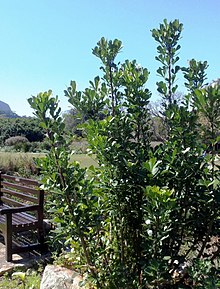
Curtisia dentata is a flowering tree from Southern Africa. It is the sole species in genus Curtisia, which was originally classed as a type of "dogwood" (Cornaceae), but is now placed in its own unique family Curtisiaceae.

Strelitzia reginae, commonly known as the crane flower, bird of paradise, or isigude in Nguni, is a species of flowering plant native to the Cape Provinces and KwaZulu-Natal in South Africa. An evergreen perennial, it is widely cultivated for its dramatic flowers. In temperate areas it is a popular houseplant.
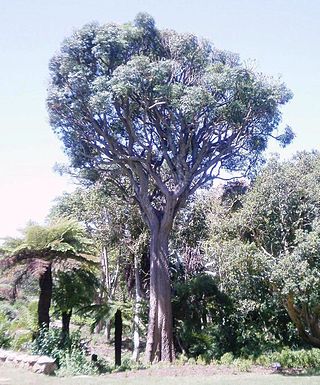
Cussonia spicata, known as spiked cabbage tree, lowveld cabbage tree or common cabbage tree, is a tree in the family Araliaceae, which is native to the moister regions of Sub-Saharan Africa. It is cultivated as a garden plant in areas without extreme degrees of frost. It is one of the favorite foods of wild elephants.
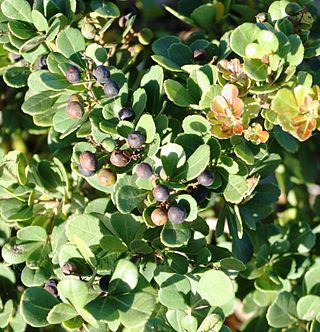
Searsia crenata, previously known as Rhus crenata,, is a species of Searsia that is native to South Africa, where it grows in frost-free and light frost areas, especially on beach sand dunes.
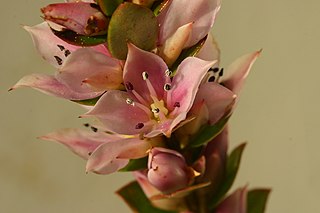
Geissoloma is a genus of flowering plants in the monotypic family Geissolomataceae, native to the Cape Province of South Africa. Geissoloma marginatum is the only species in the family. It is sometimes called guyalone in English. The plants are xerophytic evergreen shrubs and are known to accumulate aluminum.

Phygelius capensis, the cape figwort or cape fuchsia, is a species of flowering plant in the family Scrophulariaceae, native to South Africa and Lesotho.

Cussonia is a genus of plants of the family Araliaceae, which is native to the Afrotropics. It originated in Africa and has its center of distribution in South Africa and the Mascarene Islands. Due to their striking habit, they are a conspicuous and easily recognizable group of plants. Their genus name commemorates the botanist Pierre Cusson. The Afro-Malagasy and Asian Schefflera, and Afrotropical Seemannaralia genera are related taxa that share several of its morphological characteristics, among which the leaves borne on the end of branches, inflorescences carried on terminal branches or stems, and reduced leaf complexity in developing inflorescences.
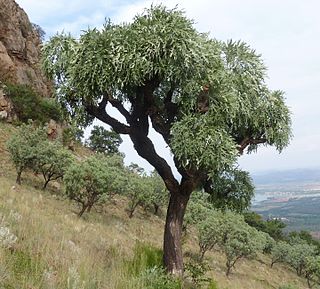
Cussonia paniculata, also known as kiepersol, is a large evergreen shrub or small tree up to 5 metres (16 ft) in height native to South Africa. The plant has large and bold textured grey foliage.

Dais cotinifolia, known as the pompom tree, is a small Southern African tree belonging to the Thymelaeaceae family. It occurs along the east coast northwards from the Eastern Cape, inland along the Drakensberg escarpment through KwaZulu-Natal and the Transvaal, with an isolated population in the Eastern Highlands of Zimbabwe. It flowers profusely during the summer months and produces a multitude of pink, sweet-scented, globular flowerheads about 10 cm across. Depending on the circumstances it can reach a height of up to 12m, although it rarely exceeds 6m in cultivation.

Euryops pectinatus, the grey-leaved euryops, is a species of flowering plant in the family Asteraceae, endemic to rocky, sandstone slopes in the Western Cape of South Africa.

Brabejum is a genus of a single species of large evergreen tree, Brabejum stellatifolium in the family Proteaceae, commonly called wild almond, bitter almond or ghoeboontjie. It is restricted in the wild to South Africa's Western Cape province, where it grows in thickets along the banks of streams. The plant is of botanical interest as being Africa's only member of the large grevilleoid subfamily. It is a bushy small tree with branches widely at ground level and numerous erect vigorous stems. Leaves grow up to 6 in (15 cm) long, narrow and bluntly toothed, appear at intervals along the branches, mostly in whorls of 6. In summer, the plant bears white flowers densely crowded on spikes arising from rusty buds at the leaf axils. The fruits to 2 in (5 cm) long, magenta to reddish brown, similar to an almond, appear in autumn. The nut is too bitter to eat; however, in earlier times it was boiled, roasted, and ground to make a "coffee" drink.

Kumara plicatilis, formerly Aloe plicatilis, the fan-aloe, is a succulent plant endemic to a few mountains in the Fynbos ecoregion, of the Western Cape in South Africa. The plant has an unusual and striking fan-like arrangement of its leaves. It may grow as a large multistemmed shrub or as a small tree. It is one of the two species in the genus Kumara.

The Middle Atlantic coastal forests are a temperate coniferous forest mixed with patches of evergreen broadleaved forests along the coast of the southeastern United States.

Myrsine melanophloeos, commonly known as Cape beech, Kaapse boekenhout (Afrikaans), isiCalabi (Zulu) or isiQwane sehlati (Xhosa) is a dense evergreen tree that is native to the afromontane forests of Africa, ranging from Nigeria and Sudan to South Africa. Outside forests they are also commonly encountered along stream banks and in gullies.

Apodytes dimidiata is a bushy tree with white flowers bearing a fragrance reminiscent of fresh coconut, and small black and red fruits. It is usually about 5 m tall, and it is indigenous to Southern Africa. The taxonomical family placement for this and other Apodytes was uncertain; it is now placed in the Metteniusaceae. Its English common name is in reference to the timber which is similar in appearance to that of the European pear tree of the northern hemisphere.

Pterocelastrus tricuspidatus, commonly called candlewood, cherrywood or kershout, is a medium-sized evergreen tree, indigenous to South Africa.

Osyris compressa is a facultatively hemiparasitic, mainly South African plant of the sandalwood family, Santalaceae. Until recently, the favoured binomial name was Colpoon compressum, but around 2001, the genus Colpoon was included in Osyris on the basis of comparative DNA studies. That assignment is not final, however, and according to the Kew Gardens plant list, Colpoon compressum P.J.Bergius, though still in review, is the accepted name.

Crassula capitella, is a perennial succulent plant native to southern Africa.

Psychotria capensis, the bird-berry, is a southern African evergreen shrub or small tree. It belongs to a genus which is used medicinally in many regions, 'Psychotria' being from the Greek for 'rejuvenating', in reference to the healing properties of certain species. Kew lists some 2,000 species of Psychotria growing throughout the warmer regions of both hemispheres, but only two of them occur in southern Africa, namely P. capensis and P. zombamontana.

Wachendorfia thyrsiflora, the marsh butterfly lily, is a plant species of 0.6–2.5 m (2.0–8.2 ft) high when flowering, that has been assigned to the bloodroot family. It is a large to very large evergreen perennial plant with an underground rootstock with clusters of roots produced at the nodes. The rootstock has a distinctive red colour that results from so-called arylphenalenone pigments. The sturdy, entire and broadly sword-shaped leaves have laterally flattened and pleated leaf blades. The golden yellow flowers are set a dense cylindrical panicle on a tall firm stalk. Flowering occurs from spring until mid-summer.
